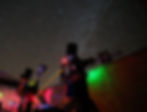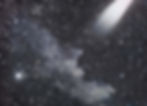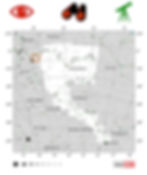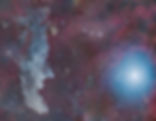IC 2118 - The Witch Head Nebula with Rigel's glow
- Antoine & Dalia Grelin
- Mar 7, 2024
- 10 min read
Updated: May 17, 2024
IC 2118 is a large but very faint reflection nebula in the constellation Eridanus, it is also known as the Witch Head Nebula. Because of its size, a DSLR camera lens or a wide telescope is required to capture the entire object in the frame. IC 2118 will show up better in photographs if you are imaging very far from light pollution. We recommend driving to a Bortle 3 site or better, and to spend at least a full night on the object. This is a good target for astrophotographers who are looking to transition from easy beginner objects to more difficult targets.
Object Designation: IC 2118, NGC 1909, Cederblad 41, LBN 959
Also Known As: The Witch Head Nebula
Constellation: Eridanus
Object Type: Reflection Nebula
Distance: 900 light-years away
Magnitude: 13.0
Discovery: Max Wolf on January 16th, 1891
Capturing the Witch Head Nebula has always been on my astrophotography bucket list. We've already imaged it a couple of times wide-field but never had the time to only concentrate on the witch.
In the northern hemisphere, the Witch Head Nebula starts to rise at a good time in October and stays high until January. This means the best time to photograph IC 2118 is in the Winter season.
The Witch Head Nebula Astrophotography with a RASA Telescope
February 2024
I decided to use the RASA 8 telescope under the Bortle 1 skies of Astronomy Acres in New Mexico to photograph the Witch Head Nebula again. This time, I wanted to make a small mosaic, of only two panels, that would include both the nebula and the bright star Rigel fully in the frame.
The clean dark skies of the observatory helped produce such great data with only 15 hours per panel.

I did not use any filters, and yet there is so much visible Hydrogen Alpha gas all over the background which is great.
If you're interested in installing your telescope permantently at a remote observatory in New Mexico, Astronomy Acres offers hosting for really good prices especially considering the Bortle1 sky and great weather most of the year! You can contact the owner through the website.
The image turned out great, and is more of what I've always wanted to do with IC2118 : A picture that shows the Witch looking towards Rigel.
Click the image to see the full-resolution version
Download our practice data for IC 2118 and see what you can achieve!
GEAR USED:
Camera: ZWO ASI2600MC
Telescope: Celestron RASA 8
Mount: 10Micron GM2000 HPS
Accessories: Celestron Focuser / PrimaLuceLab Eagle 5S
Processing: Pixinsight, with R-C Astro plugins. Final touches in Skylum Luminar Neo
ACQUISITION DETAILS:
Total Exposure Time: 30 hours
Exposure Time per frame: 300 seconds
Filters: N/A
Gain: 100
The Witch Head Nebula with a Beginner Refractor Telescope
February 2020
This was my first time imaging the Witch Head Nebula seriously.
I packed my telescope gear and drove 4 hours to a Bortle 2 zone in the desert of Arizona, the road was incredibly rough (you might have seen my story on Instagram if you follow us!) and I did not think my car would keep all its tires by the time I got to the site.

I was very excited to start imaging IC 2118, and even decided to take a risk with the framing to make the final result more unique.
You will see the result below, and you might either love it or hate it, but you can't argue that it isn't unique!
Sadly, it only took a couple of hours before clouds decided to roll in, forcing me to pack and drive 4 hours back to Vegas. I can't even describe how relieved I was to reach home with my car still running fine. I truly expected it to explode at any time.
Thanks Toyota for making indestructible cars.
On the right, you can see the setup used to capture the image.
We previously imaged the Witch Head Nebula with a DSLR camera and a 50mm lens.
We spent a total of 7 hours on it at this focal length and you can see the result on the left.
Note that this is a crop from the full image, which you can see on our Barnard's Loop post. You may also want to watch Episode 8 of Galactic Hunter to see us photograph this wide-field target using our DSLR camera attached to our motorized mount.
For my first image of the witch with a telescope, I decided to take a risk, and position Rigel just on the outer edge of the frame. Although the star itself is not visible, its powerful glow is.
You can see what I mean below. Sure, this is not going to be for everyone's taste, but my goal was to give this image a "unique" look that was not done in the past. We accidentally learned about the glow bright stars could cause when just outside of the frame when photographing the cluster Messier 103.
Do you love it? Do you hate it? Let us know in the comments below!
IC 2118 in LRGB with the ASI 1600MM

GEAR USED:
Camera: ZWO ASI 1600MM
Telescope: Meade 70mm APO
Mount: Orion Atlas EQ-G
Guiding: ZWO ASI 290MM Mini
Acquisition: ZWO ASIAIR
Processing: Pixinsight
ACQUISITION DETAILS:
Total Exposure Time: 2 hours and 30 minutes
Exposure Time per frame: 3 minutes
Filters: L (1 hour) / R (30 min) / G (30 min) / B (30 min)
Gain: 139
How to find the Witch Head Nebula?

The Witch Head Nebula can be found 2.6 degrees west of Rigel, the 7th brightest star in the night sky. Although Rigel is part of Orion, IC 2118 is considered to be in the neighbor constellation of Eridanus.
The Witch Head nebula is extremely faint and almost impossible to see. It is of course not visible to the naked eye, and it is debatable whether it can be spotted with binoculars or not. Using a pair of wide binoculars under truly dark skies might reveal what seems to be an elongated patch of darkness. We personally never managed to see it with ours.
Viewing this nebula with a telescope is also a challenge. The recommended way to do it is to use a small telescope with wide band and narrow filters attached, even then, the Witch Head is far from being impressive visually.
Not many popular deep sky objects are located near Witch Head Nebula, besides the Orion Nebula (M42) and the Horsehead Nebula (IC434).
Witch Head Nebula Information
The Witch Head Nebula got its name because it looks like the profile of a witch. It is facing towards the bright blue supergiant star, Rigel.
Let's learn some more about the Witch Head Nebula, its discovery, and Rigel as well!
The Witch Head Nebula by NASA

NASA's official page about the Witch Head Nebula shows a photograph of the object captured from Earth-based telescopes. Sadly, there aren't any pictures of IC 2118 taken with space telescopes, like the Hubble Space Telescope or the James Webb Space Telescope.
This image shows the beautiful With Head Nebula, with a blue-dominant background, which emphasizes the powerful glow of the blue supergiant star. Talking about Rigel, it is not visible in this field of view, and would be some ways off to the right side.
This image of IC 2118 was made with NASA's STScl Digitized Sky Survey in blue, red, and infrared. The data was processed by Noel Carboni.
Rigel - The Blue Supergiant Star near the Witch Head Nebula
Let's quickly talk about Rigel, a beautiful blue supergiant that is also the 7th brightest star in the sky.

Rigel, also known as Beta Orionis, appears very close to IC2118 in photographs, but it is technically in the Orion constellation and not Eridanus. Rigel is located 863 light-years away from Earth, so at a similar distance as the nebula. The star is believed to be around 40 to 50 light-years away from the Witch.
Rigel is between 61,500 to 363,000 times brighter than our Sun, and 18 to 24 times more massive. Researchers expect Rigel to die as a type II supernova, and become either a neutron star or a black hole.
The star system that hosts Rigel is also believed to be home to at least three other stars, not visible through Earth telescopes due to the glare of the bright star.
I have always loved wide-field images of the Witch Head Nebula because it always looks like the witch is staring at Rigel. Although I used a wide telescope to capture this object, there was no way for me to include both the witch and Rigel in the same frame unless doing a mosaic.
Discovery and First Image of the Witch Head Nebula

The Witch Head Nebula was discovered in January 16, 1891 by Max Wolf, a German astronomer.
Wolf discovered the nebula using astrophotography, back then with photographic plates and a 4-inch Millet portrait lens. The integration time was one hour.
Wolf took several images of the object over the years, and confirmed its discovery in March 1905, in the 65th volume of the Monthly Notices of the Royal Astronomical Society.
The attached image shows the object photographed by Max Wolf and that was attached in his 1905 announcement.
And below you can see a comparison image between Max Wolf's 1891 picture of the Witch Head Nebula, and ours taken in 2024, 133 years later with much better equipment and modern processing techniques.

Cool Facts About the Witch Head Nebula
Discovered with Astrophotography in 1909
About 900 light-years away from Earth
Orion’s brightest star Rigel shines on the Witch’s gases
Processing of IC 2118
2020 version
The Witch Head Nebula is definitely not a great target for narrowband imaging, so we opted for the 4 LRGB filters:
Luminance
Red
Green
Blue
How much data can you get with each filter?
Below are the combined results for each channel.
From left to right:
One hour on L
30 minutes on R
30 minutes on G
30 minutes on B
You may notice that the glow from Rigel is only visible on the Luminance and Red channels. This is because the ASIAir decided to do an automatic Meridian Flip ,midway through the imaging session and did not recenter exactly as it was before...
This also made the reflection on our final image white with a tiny hint of red, instead of being colorful.
Witch Head Nebula Processing Tutorial Video and Raw Data
As for the 2024 version, processing was fun but also difficult! The 2 panels of data first had to be stitched into one file, and then processed as a single master. It was time-consuming to fix all the small stitching issues that often show after combining mosaic panels, and revealing as much gas and dust as possible without blowing up Rigel was tricky.
I recorded a full walkthrough video in 4K so that you can follow along from beginning to end and process the image exactly the way I processed mine. You can download this video, along with the full-resolution data below.
IC 2118 FAQ
In which constellation is IC 2118 located?
You can find the Witch Head Nebula in the constellation Eridanus.
How big is the Witch Head Nebula?
The nebula has a diameter of 70 light-years. From Earth, it has a size of 1 x 3 degrees!
How far is IC 2118?
The Witch Head Nebula is located about 967 light-years away from Earth.
How long should my exposure times be when photographing IC 2118?
We suggest doing 10-minute exposures or more for this object although, if like us, you are using a very fast telescope (f/2) from a Bortle 1 site, 5-minute exposures will be enough. The Witch Head Nebula is very faint, and as a reflection nebula, you will want to spend as many hours on it as possible to get a good result!
Should I use a filter to image the Witch Nebula?
IC 2118 is a broadband target, but its background is full of Hydrogen Alpha. Although you do not need a filter for this target if you have dark skies and a fast telescope, it is always a good idea to also use an HA filter to get the best out of all that background gas.
Final Thoughts
The Witch Head Nebula is a difficult but great target for both beginners and advanced astrophotographers. You should be able to get a result you are proud of either way, as long as you have enough data and your imaging site isn't too light-polluted.
Have you captured the Witch Head Nebula? Attach your image in the comments and let us know what you used!
Clear Skies,
Galactic Hunter
GALACTIC HUNTER BOOKS
Description: Discover 60 Deep Sky Objects that will considerably improve your Imaging and Processing skills! Whether you are a beginner, intermediate, or advanced astrophotographer, this detailed book of the best deep sky objects will serve as a personal guide for years to come! Discover which star clusters, nebulae, and galaxies are the easiest and most impressive to photograph for each season. Learn how to find each object in the night sky, and read our recommendations on imaging them in a quick and comprehensive way. Each target in this guide contains our advice on imaging, photos of expected results, and a useful information table. We've also included a few cool facts about each target, a map to find it in the night sky, and more!
Description: The Astrophotographer’s Journal is a portable notebook created for the purpose of recording observations, cataloguing photographs, and writing down the wonderful memories created by this hobby. This book contains more than 200 pages to memorialize your stargazing and imaging sessions, as well as a useful chart on the last pages to index exciting or important notes. Read back on the logs to see how much progress you have made through the months, the problems you overcame, and the notes taken to improve in the future. Just as the pioneers of astronomy did in their time, look up and take notes of your observations as you are the author of this star-filled journey.
Description: The Constellations Handbook is a logical guide to learning the 88 constellations. Learning the constellations is difficult. Remembering them is even harder. Have you ever wanted to look up to the night sky, name any pattern of stars and be able to tell their stories? This book groups the constellations in a logical order, so that the reader can easily learn them by their origin, and see how their stories interact with one another as a group. The last pages of this book include an index of all 88 constellations, each with a slot where you can write your own personal tips and tricks in order to memorize them with ease. The Constellations Handbook is not just another guide listing all the constellations from A to Z and their location, it is the perfect companion for stargazing, and a learning journey through the ages.




















